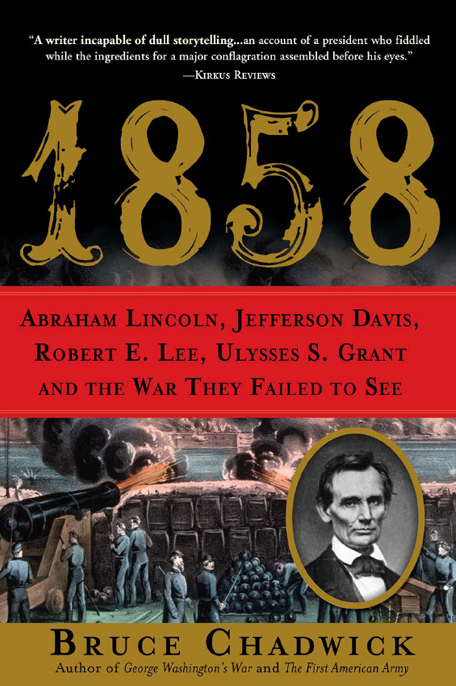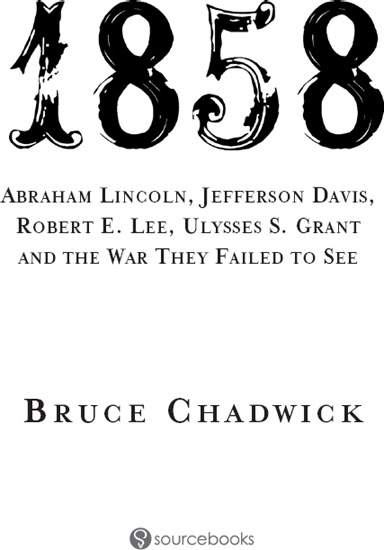1858
Authors: Bruce Chadwick



© 2008, 2011 by Bruce Chadwick
Cover and internal design © 2008 by Sourcebooks, Inc.
Cover images © Corbis Images
Internal photos used by permission as noted in captions
Sourcebooks and the colophon are registered trademarks of Sourcebooks, Inc.
All rights reserved. No part of this book may be reproduced in any form or by any electronic or mechanical means including information storage and retrieval systems—except in the case of brief quotations embodied in critical articles or reviews—without permission in writing from its publisher, Sourcebooks, Inc.
All efforts have been made by the editors to contact the copyright holders for the material used in this book. The editors regret if any omissions have occurred and will correct any such errors in future editions of this book.
Published by Sourcebooks, Inc.
P.O. Box 4410, Naperville, Illinois 60567-4410
(630) 961-3900
Fax: (630) 961-2168
The Library of Congress has catalogued the hardcover edition as follows:
Chadwick, Bruce.
1858 : Abraham Lincoln, Jefferson Davis, Robert E. Lee, Ulysses S. Grant, and the war they failed to see / Bruce Chadwick.
p. cm.
Includes bibliographical references.
1. United States—History—Civil War, 1861-1865—Causes. 2. United States—Politics and government—1857-1861. 3. Politicians—United States—Biography. 4. Generals—United States—Biography. 5. Politicians—Southern States—Biography. 6. Generals—Southern States—Biography. 7. Secession—Southern States. 8. Southern States—Politics and government—1775-1865. I. Title. II. Title: Eighteen fifty-eight.
E458.C425 2008
973.7’11—dc22
2007039254
Printed and bound in the United States of America.
VP 10 9 8 7 6 5 4 3 2 1
Margie
and Rory
CONTENTS
C
HAPTER
O
NE
: T
HE
W
HITE
H
OUSE
, N
EW
Y
EAR
’
S
D
AY
1858
C
HAPTER
T
WO
: T
HE
D
EATH
OF
J
EFFERSON
D
AVIS
C
HAPTER
T
HREE
: T
HE
W
HITE
H
OUSE
, E
ARLY
1858:
C
HAPTER
F
OUR
: C
OLONEL
R
OBERT
E. L
EE
L
EAVES
C
HAPTER
F
IVE
: T
HE
W
HITE
H
OUSE
, F
EBRUARY
1858:
C
HAPTER
S
IX
: H
ONEST
A
BE AND THE
L
ITTLE
G
IANT:
T
HE
L
INCOLN
-D
OUGLAS
D
EBATES
, P
ART
O
NE
C
HAPTER
S
EVEN
: T
HE
W
HITE
H
OUSE
, J
ULY
1858
C
HAPTER
E
IGHT
: H
ONEST
A
BE AND THE
L
ITTLE
G
IANT:
T
HE
L
INCOLN
-D
OUGLAS
D
EBATES
, P
ART
T
WO
C
HAPTER
N
INE
: T
HE
W
HITE
H
OUSE
, A
UTUMN
1858:
C
HAPTER
T
EN
: O
BERLIN
, O
HIO
: T
HE
R
ESCUERS
C
HAPTER
E
LEVEN
: T
HE
W
HITE
H
OUSE
, O
CTOBER
1858
C
HAPTER
T
HIRTEEN
: T
HE
W
HITE
H
OUSE
, E
LECTION
D
AY
C
HAPTER
F
OURTEEN
: W
ILLIAM
T
ECUMSEH
S
HERMAN
:
C
HAPTER
F
IFTEEN
: T
HE
W
HITE
H
OUSE
, W
INTER
1858:
C
HAPTER
S
IXTEEN
: T
ERRIBLE
S
WIFT
S
WORD
:
J
OHN
B
ROWN’S
C
HRISTMAS
R
AID
INTO
M
ISSOURI
C
HAPTER
S
EVENTEEN
: T
HE
W
HITE
H
OUSE
,
The gratification in writing about history is not the publication of the book, but the journey to that moment. My journey on this book was long and complicated because I found myself writing biographies in one long story about one of the most critical twelve-month periods in American history. I realized that I needed plenty of help to tell the story of
1858
and I received it.
I want to thank many people for their assistance in my work on
1858
, but first I want to thank Hillel Black, my editor and the executive editor of Sourcebooks. Hillel, a lover of history, helped me make an entire story out of seven fragmented tales in this work and has, over the years, encouraged me in all of my work about history. Also at Sourcebooks, I must thank Tara Van Timmeren, who also edited the book, and Heather Moore, the hardworking director of publicity.
My tracking of the year 1858 took me to numerous libraries, archives, and museums. Many thanks to the gracious people at the Virginia State Library, the Abraham Lincoln Presidential Library, Princeton University’s Firestone Library, Rutgers University’s Alexander Library, the David Library of the American Revolution, Cindy Van Horn at the Lincoln Museum, Ronald Baumann at Oberlin College, Lisa Keys at the Kansas State Historical Society, Elizabeth Hogan at the University of Notre Dame Archives, Mary Troy and historian Frank Cucurrulo at Arlington House, the Robert E. Lee Memorial, Heather Milne at the Museum of the Confederacy, Mike Coker at the South Carolina Historical Society, Peter Wisbey at the William Seward House Museum, and Jim Gerswenc at Dickinson College Library.
Dr. Michael Birkner at Gettysburg College was kind enough to read through the Buchanan chapters of the book and offer suggestions. Thanks, too, to Fred Smith, at New Jersey City University’s Guarini Library, and to Jo Bruno at New Jersey City University for their encouragement.
I want to thank my agents at McIntosh and Otis, Elizabeth Winick and Jonathan Lyons, plus Rebecca Strauss, for their support in this project and my other work.
And, as always, thanks to my wife Marjorie for her never-ending assistance and for sharing my hopes and dreams.
The Civil War began in April 1861, when Confederate forces in Charleston, South Carolina, bombarded Fort Sumter, ensconced on an island in the city’s harbor. The terrible conflict has resulted in hundreds of books about the war, its battles, causes, and aftermath. This book explores the events and personalities of a single year to show what happened in those twelve months that would set the nation, North and South, on a collision course that culminated in the war that ripped the country apart and brought about the deaths of more than 630,000 young men.
The record of that year is told within seven separate stories that stand alone as complete sagas, and together explain what happened throughout the nation that year, a year in which slavery came to dominate every election and discussion from the gold fields of California to the mansions of Boston to the campaign trail in Illinois. The stories of events of that critical year include: Mississippi senator and Mexican War hero Jefferson Davis, who later became the president of the Confederacy, nearly died, but recovered to become the nation’s secessionist spokesman. A disgruntled Colonel Robert E. Lee, who later led the Confederate Army, had to decide whether he would resign from the military, disappear from public life and return to his beloved Virginia to run his wife’s family plantation. William Tecumseh Sherman, one of the great Union generals in the Civil War, left the army to make his wife happy. He had failed at a number of jobs, and by the fall of 1858 he was reduced to running a roadside food stand in Kansas.
In autumn of that year, two dozen residents of Oberlin, Ohio, freed a slave that had been apprehended by slave catchers from Kentucky; their arrest and well-publicized trial set off a firestorm of debate across America. During that same autumn, in the middle of the elections, New York Senator William Seward seemed to solidify his hold on the 1860 Republican presidential nomination with a fiery speech in Rochester, New York, in which he told the country that all Americans were engaged in an “irresistible conflict” over slavery that might end in Civil War. That winter, abolitionist fanatic John Brown, who later attacked Harper’s Ferry, freed several slaves in a daring raid in Missouri, marching them eleven hundred miles to Canada in a trek involving chases and gunfights that the nation’s newspapers covered from coast to coast. And, of course, 1858 was the year in which the famous U.S. Senator Stephen Douglas, certain to be the Democratic presidential nominee in 1860, engaged in seven historic debates with little-known Abraham Lincoln in their Illinois senate race.
At the same time that all of these events transpired, at the White House President James Buchanan ignored slavery, engaged in questionable imperialist schemes, divided his own party during the elections, started feuds with dozens of important people, and exhibited a distinct lack of leadership at a time when the nation desperately needed some. The stories of his meanness and ineptitude will hold the seven main stories together to offer a comprehensive account of a nation of angry people, North and South, drifting toward one of the tragic conflicts of history.
I thought that evoking the events of that critical year with seven dramatic stories, linked by the chronology of James Buchanan’s presidency and his insistent fumbling, would be more beneficial than writing a straight history of those crucial twelve months. Within this format, event by event and person by person, I think I can explain how the country reluctantly, and perhaps inevitably, stumbled toward that moment in April 1861, when the guns in Charleston opened up on Fort Sumter.
